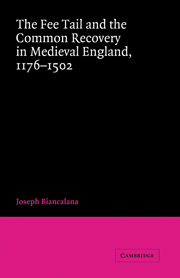Book contents
- Frontmatter
- Contents
- Acknowledgments
- List of abbreviations and abbreviated citations
- Introduction
- 1 Fee tails before De Donis
- 2 The growth of the “perpetual” entail
- 3 Living with entails
- 4 Barring the enforcement entails other than by common recovery
- 5 The origin and development of the common recovery
- 6 The common recovery in operation
- Appendix to Chapter 6
- Bibliography
- Subject and selected persons index
- Index to persons and places in Appendix to Chapter 6
5 - The origin and development of the common recovery
Published online by Cambridge University Press: 28 July 2009
- Frontmatter
- Contents
- Acknowledgments
- List of abbreviations and abbreviated citations
- Introduction
- 1 Fee tails before De Donis
- 2 The growth of the “perpetual” entail
- 3 Living with entails
- 4 Barring the enforcement entails other than by common recovery
- 5 The origin and development of the common recovery
- 6 The common recovery in operation
- Appendix to Chapter 6
- Bibliography
- Subject and selected persons index
- Index to persons and places in Appendix to Chapter 6
Summary
This chapter traces the development of the common recovery from its beginning in 1440 to 1502. There were a handful of recoveries in most years of the 1440s and about a dozen in each year of the 1450s. Thereafter the number of recoveries grew more or less steadily. By 1502, when there were 240 recoveries, the recovery was a well-established means of conveying land. Part 1 of this chapter presents the evidence about the origin and the increasing frequency of recoveries.
The procedure of a common recovery was fairly simple. Suppose A holds land in fee tail but wishes to grant the land to B and to bar the entail. A grants the land to B and then B brings an action for the land against A in the Court of Common Pleas. A denies B's right and vouches a warrantor who enters into the warranty and defends the action. The grantee-plaintiff, B, pleads against the warrantor, who denies B's right. Either the plaintiff or the warrantor then requests and receives a continuance. On the day appointed to resume the case, the warrantor absents himself. The court gives a default judgment for B against A and for A against the defaulting warrantor. The plaintiff, B, might or might not sue out a writ to execute the judgment.
Each step in the basic procedure required a decision by the parties.
Information
- Type
- Chapter
- Information
- The Fee Tail and the Common Recovery in Medieval England1176–1502, pp. 250 - 312Publisher: Cambridge University PressPrint publication year: 2001
